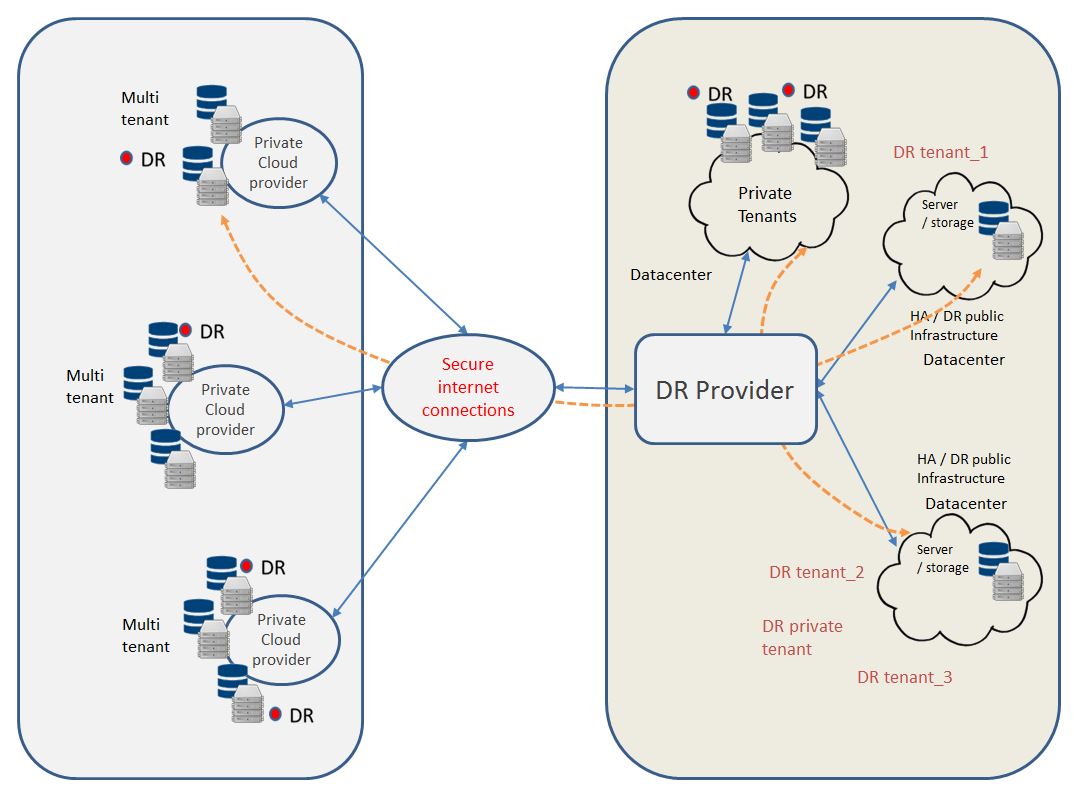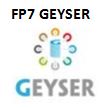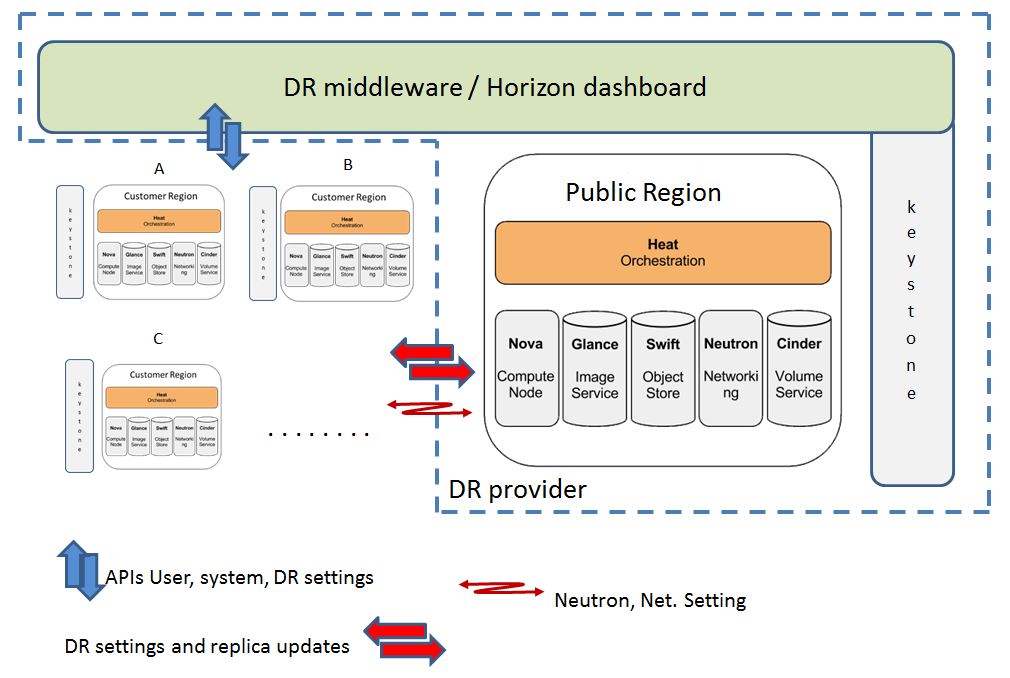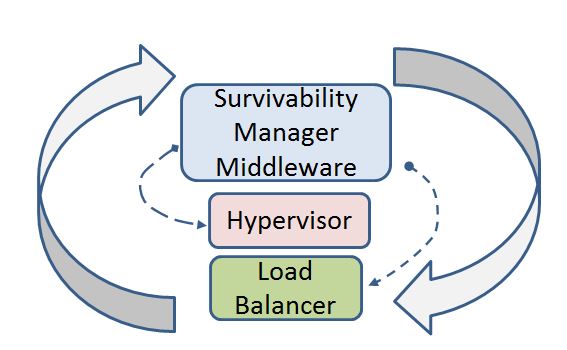ZHAW Service Engineering ICCLab periodically sends Newsletters with information about latest activities of the lab and relevant events. This is the newsletter for November 2014 and the last for the year 2014.
In this issue
- Editorial
- Foreground
- Major event: OpenStack Summit 2014
- Next events: Swiss FIWARE Acceleration Conference
- Relevant call for papers
- Project Corner
- Communities
- Tutorial: Design of Disaster Recovery services
Editorial by antonio cimmino
Today the over the top business, played around the internet, is strongly related to the acquisition and subscription of end-users. There are technologies or applications that are capable to trigger massively acquisition of end-users. When strategically planned from the beginning, the value of the target market would be huge and global. Look for example whatsapp, the technology choice was based on mobile phone number subscription although the effective message channel is based on the public internet. The same application could be had been conceived as instant messaging uncorrelated to the mobile, as many available on the marketplace. Well this choice has opened the application to a huge arena of mobile subscribers, worldwide. The value of the application resides also in the mobile numbers and SIM info. This subscriber database is also unrelated to a single mobile operator. Currently there are 6 Billions and more of mobile subscribers (85% whatsapp penetration rate). The impacts on the dimension of underlined serving Cloud Infrastructure, for subscriber management and messaging, can only be guessed. It is now part of FaceBook which has now included as subscriber access info the mobile number! This is a first example. Another important trigger is the fact that mobile applications can associate free File Synchronization and Sharing services to all subscribed devices even not related to the serving mobile operator. It means that the market access would be based on another criteria like the brand of the device. This is the case of apple iCloud which is linked to the subscribed apple (iPhone) devices. One of the main objectives is to provide file sharing services and storage. The cloud infrastructure is huge and some of the strategic moves initiated in the 2010 and the diffusion of Apple datacenters today is strongly progressing, despite very few magic quadrants are reporting the iCloud. The market share of apple is around 41.4 %. iCloud offers 5GB of storage for Free and cheap 20GB of storage – $0.99 per month, which yields availability of thousands of Terabytes in the Apple datacenters.
Foreground
In contradiction with the Mobile World Congress which represents the biggest unique event for mobile and wireless technologies, there are at least two annual large events organised for the cloud technologies. The 7th Cloud World Forum that will be held in June next year.
Both the events have also multi locations / countries editions and editions dedicated to specific market sectors (Enterprise, BigData, Telco). One of the reasons could be the technology maturity and respective hype cycle positions. For sure, the reality is that around cloud computing and virtualisation technologies there is a very big three digits billion market. Cloud based infrastructures are also accelerating adoption of other technologies like NFV, SDN and 4G mobile. Cloud computing is interesting for a majority of any size enterprise and the discussion about public vs. private has generated the hybrid configurations for which 2/3 of enterprises have adopted as strategy. These and other interesting themes will be presented and analysed at both the events (cloud expo and CWF). For example, case studies demonstrating how the enablement of digital enterprise through pioneering solutions, Unified Communications, social mobile collaboration, virtualisation, security or cloud migration technologies.
___________________________________________________________________________________
Major event: OpenStack Summt Paris 2014
Paris, 3-7 Nov 2014
Srikanta Patanjali: Srikanta Patanjali – Cyclops – A Dynamic Rating, Charging & Billing software for OpenStack — link http://youtu.be/NDcLS-Lxxd4
Vojtech Cima – Performance analysis of live migrations in Openstack
http://youtu.be/vvbCio_0FGQ
Related post:
http://blog.zhaw.ch/icclab/performance-of-live-migration-in-openstack-under-cpu-and-network-load/
______________________________________________________________________________________
Next events: Swiss FIWARE Acceleration Conference
ZHAW ICCLab Winterthur, 5 Dec 2014
ZHAW ICCLab Zurich University of Applied Sciences
Technikumstrasse 9, 8400 – Winterthur CH – Room: TL201 (chemistry building)
“Enjoy the €80 million euros of direct funding, mentoring and networking to create your innovative Internet application with FIWARE technologies. Join the Future Internet Accelerator Programme and choose the accelerator that suits your project best!
The event offers, to SWISS Small Enterprises and WEB entrepreneurs, the opportunity to introduce project ideas to the professional A16 accelerators. They will guide you through the difficult time of developing your application and building your business with their expertise.
FIWARE in collaboration with FI-PPP projects join forces to host a series of events in several cities, bringing an excellent opportunity to receive training and coaching on FIWARE.
The day is structured to :
- provide overall introduction of the main FIWARE Generic Enablers needed to develop your first application based on FIWARE
- support Small Enterprises and Web entrepreneurs to apply to the open calls in Dec 2014 and early 2015.
AGENDA
9:00-10:00 Registration and Welcome
10:00 Future Internet PPP – European Commission,Ragnar Bergström
10:30 FIWARE project and ecosystem – ZHAW ICCLab, Thomas Michael Bohnert MB
11:00 Swiss industry representative: Equinix
11:30 A16 Speedup! Europe Open Calls – Olaf-Gerd Gemein
12:00 Break
12:15 A16 SOUL-FI Open Calls, Nuno Varandas
12:45 Networking Lunch – A16 face to face meetings
13:30 Guide to the applicants
14:00 Wrup-up and Closing
http://www.cloudcomp.ch/2014/10/swiss-fi-ware-acceleration-conference-announcement/
related posts: http://blog.zhaw.ch/icclab/the-soul-fi-sme-event-fiware-acceleration/
_________________________________________________________________________________
| NIDISC 2015 |
18th International Workshop on Nature Inspired Distributed Computing
|
Hyderabad, India
May 25, 2015
|
December 19, 2014 Anywhere on Earth |
|
Computer networks
|
IJIS |
International Journal of Information Security
|
Tunisia
Dec 29, 2014
|
December 27, 2014 05:59:00 Europe/Berlin |
|
Parallel and Distributed Computing
|
IEEE IPDPS 2015 |
29th IEEE International Parallel & Distributed Processing Symposium
|
Hyderabad, India
May 25, 2015
|
January 9, 2015 17:00:00 Etc/GMT+12 .. January 25, 2015 Anywhere on Earth |
|
Computing & Communications
|
ISCC2015 |
20th IEEE Symposium on Computers and Communications
|
Larnaca, Cyprus
Jul 6, 2015
|
January 26, 2015 20:59:00 America/Los_Angeles |
|
Computing & Communications, Information Systems
|
WSCAR’ 2015 |
2015 World Symposium on Computer Applications & Research
|
Rom, Italy
Mar 23, 2015
|
March 20, 2015 00:00:00 America/New_York |
______________________________________________________________________________
Project Corner
T-NOVA released its second specification document, proposing an integrated top-down NFV system architecture for the provision of Virtual Network Functions as-a-Service. The T-NOVA architecture reuses ETSI NFV concepts for the lower architectural layers, while it introduces novel entities, including an NFV Marketplace with the aim of accelerating the market uptake of the VFNaaS business case. The defined architecture is reasonably complex and feasible to realise, being compatible with existing state-of-the-art IT and network infrastructures and will be fully implemented in the course of the project.
FI-PPP workshop @ FOKUS FUSECO Forum 2014
13 November 2014, Berlin, Germany
As a continuation of the successful FI-PPP workshop @ FOKUS FUSECO Forum 2013, XIFI is organizing an international FI-PPP workshop, hosted in conjunction with the 5th FOKUS FUSECO Forum 2014, 13th of November 2014, Berlin, Germany.
The theme of this year’s FI-PPP workshop is:Bridging the gap between Future Internet Research, Innovation and Business.
Recognition & Reward Programme has been designed to encourage infrastructures joining XIFI to provide real engagement with and participation in the FIWARE Lab Federation.
MOBILE CLOUD NETWORKING
MobileCloud Networking is a European research project (18 partners, 15.7M EUR) that, based on the research it carries out, is providing an implementation of NFV. The architecture is NFV compatible and leverages various standards to ensure interoperability, such as 3GPPP, TMForum and OCCI. Recently the consortium met to review progress. Two key events that MCN will attend and present demonstrations of their implementation are:
- Industrial track at IEEE Globecomm 2014
- Mobile World Congress 2015
In each demonstration complete telco software stacks will be created and composed on-demand to deliver full end to end services. This includes Radio Access Network (RAN), Evolved Packet Core (EPC) and (IMS) services. Key technologies that are used in this include OpenStack and OpenShift Origin along with the service orchestration framework developed here at the ICCLab.
The project is a supporting action to the entire FI-PPP programme. Recently, the project has been re-focused to support the implementation of the phase-3 (last phase) of the programme which is dedicated to the acceleration of the FIWARE adoption bt developers and startups. The ECFI2 event in Munich also started publishing the open calls. The re-organisation of the project activities is now concentrated to the start of the programme office team foreseen for the 20 Nov.
FI-WARE / FICORE
Kick off of FI-CORE (the FI-WARE continuation) was held in October. The next newsletter will give details about progress and new objectives of the prohject.
Having just past its first birthday, the GEYSER project is beginning to walk. The project – which focuses on Energy Efficient Data Centres in the context of Smart Cities – has defined a system architecture for management of DCs in the context of diverse energy supplies. The project team is in the early stages of turning this system architecture into a demonstrator and is choosing implementation tools and dividing the work between the partners. An early demonstrator of the project work will be available in Q1 next year.
From the ZHAW perspective, our work on live migration (reported at Openstack Summit as noted above) has been well received and we continue to progress with this timely work considering more advanced migration mechanisms and understanding when and how to use migration to achieve energy efficiencies.
_
____________________________________________________________________________________
Communities
8th Swiss Openstack User Group meetup
The 16th Oct 2014 there was great participation to the OpenStack User Group – Meeting at ICCLab in Winterthur. We have co-located it with docker CH meetup. In total, around 60 participants from both the user groups. For this event, the agenda was organised with the objective of having a good mix of big players and developers presentations.
NEXT meetup will be hosted by SWITCH in Zurich. Most probably at the end of Feb. or first week of March. to be confirmed.
SWISS OPENSTACK USER GROUP the Call for speakers 2015 is open, please contact the editor or post on meetup
Swiss Special Interest Group – Cloud Computing
The group is progressing on the action items and in particular with the preparation of the General Assembly on 25 Nov 14. The SI green IT SIG will introduce the organistion of his group. The main web page of the SIG CC is on-line since October and available on http://www.cloudcomp.ch/ . The blog sections is also operative and at next plenary we will define its utilisation by all members.
Please use the free registration form at
http://www.cloudcomp.ch/events/si-sig-cc-plenary-registration/
The participation is not restricted to the members.
Swiss SDN workshop
20th. of November 2014 – ZHAW, ICCLab
Location – http://goo.gl/O1B9oD Building TW – Technikumstrasse 20/22, CH-8400 Winterthur
The aim of the workshop is to continue our discussions on SDN/NFV: To continue the dialogue OpenSource vs. OpenSystems; to have impressions about (open) standards and recommendations from SDOs like ETSI/SDNRG explained on Use Cases; to show the attractiveness of test bed environments for R&D supporting clouds on SDN, operations and SDN frameworks. Further more hands on sessions/demonstrations will be very welcome.
_
______________________________________________________________________________
Tutorial
Disaster Recovery Services – part-1
I give here a first overview of architectures and ecosystems possible for Disaster recovery services. The full blog post dedicated to this topic will be delivered soon!
1.0 Introduction
Disaster Recovery (DR) is the process of ensuring continuity of a set of workloads following, or anticipating, large scale disasters that disrupts the current environment or infrastructure. By large scale disaster, we are considering disasters which can lead to a complete loss of a data center such as floods, tornadoes, hurricanes, fires, etc. To provide DR, we need a geographically distant site which will be the target of recovery. Any resources, data, etc., needed by the application to recover need to be at the target site prior to the disaster. There is a substantial difference from the High Availability in the cloud which is the mechanism for continued operations within a single cloud environment. More in general, the DR will be the mechanism for continued operations in multiple cloud environments. In this context DR is a continued workload operations in an alternative deployment, the recovery target infrastructure that could be or not be based on cloud.
2.0 Architecture requirements in OpenStack environment
A possible architecture should allow to take snapshots of interested Virtual Machines, create copies and place the redundant copies in an OpenStack region that is also geographically different from the region of the original VMs. The region must be a different one, because VMs that live on the same physical host are not resistant to disasters or safety risks. In order to make VMs highly available to the outside world, the traffic to the VMs should be routed through some load balancer, or DR PaaS middleware, which can distribute traffic evenly over the redundant VMs. A good idea to handle the traffic is to employ OpenStack’s Heat component which can be used to bind number and size of multiple VMs elastically to traffic volumes. Heat orchestrator works primarily on infrastructure, but it is also compatible to software configuration management tools like Chef or Puppet. A great challenge will be the synchronization of original VMs with their redundant copies. The (virtualized) hardware and software configurations of copies and originals should be kept in sync. In case the cloud provider actor is different from the DR provider, the stacks have to be organised in a way that migration and updates of redundant copies should be authorised between the two domains. Open questions are for example: to meet same SLA and business continuity on recovery clould, how to identify / flag the tenant environment (data, applications) that will be protected and continued in case of disaster.
3.0 Use case and ecosystem for DR services.
Many cloud providers or organizations today do not offer cheap disaster recovery services which are considerated expensive, complex and unreliable for the most mission-critical applications. The best disaster recovery should provide great protection at the lowest possible cost. DR is already a service of big players like AWS, vMWare and other organisations. Some business criteria could be: Recoverability (*), Diversity of IT application environments, Affordability by the DC operations.
We can identify, for the cloud case (fig.1), these Stakeholders:
- Private Cloud: customer of the DR provider
- DR Provider: Disaster recovery provider
- Tenant: customer of the Private Cloud
 Fig.1 Use case and ecosystem for DR services
Fig.1 Use case and ecosystem for DR services
The DR provider role would include services like: management of subscriptions, DR set-up and setup of local DR customer tools / APIs, DR tenant management and deployment strategies, local HA for DR tenant images. The DR provider may host other tenants beside the DR service and therefore the DR service may also be offered to them beside the normal Ha requirements. This local tenant DR service architecture would have probably lower challenges than the external DR customers .
4.0 DR service lifecycle
For this specific service we can design a life-cycle like the one depicted in figure. 5. However, more on IT incident management strategies and standards can be found on this page . and on ISO 27031 and ISO 24762.
Types of DR service subscription may also include the frequency of replicating the original application to the recovery infrastructure (recovery level). For example: “Gold” profile for application service that requires the highest protection level with the shortest recovery point objective (RPO) and the shortest recovery time objective (RTO). Such a DR policy can be based on synchronous replication and hot backup site. Other policies such as “Silver” based on periodic replication, or “Bronze” based on async replication with low capacity standby site for application services that require lower protection levels with longer Recovery Point Objective RPOs & Recovery Time Objective RTOs
5.0 Experiment plan
The lab is following the progress of the project initiated in OpenStack
and the intention is to make a local testbed utilising the two OpenStack clouds available at the ICCLab as follows:
Lisa DR data center – Region 1 (DR infrastructure provider)
- Backup images (storage and VM)
- DR tenants
- DR manager and broker
- Post incident management
Barth Cloud Services – Region 2 (DR customers)
- Cloud hosting
- Tenant subscriptions for DR service
- Monitoring and triggering
- pre-incident duplication and updates
- Client DR manager (functions: . . . . .)
- post-event restore
There are functions that would be at a higher level which can be defined as a Survivability management middleware. The scope is to logically link two o more OpenStack environment (even as domain administrated by different subjects) and to coordinate the DR lifecycle according the plan in Fig. 2.
Following figure 3 shows a possible configurations and elements to be considered when a single OpenStack environment (DR provider) will host recovered environments of various CloudStack environments. In principal this architecture could be realised with any virtualised environment even not based on OpenStack.
In order to design a DR service in OpenStack there are many requirements to be taken into account and designed like: to set-up a multi region secure environment encompassing the customers and the DR provider scalable Infrastructure (Heat should help solving this aspects), DR provisioning and subscription (at tenant level or at application level), periodical duplication of customer data (VM, storage, meta-data), test on DR provider before disaster events, design of monitoring and context broker middleware for event / alarm management, DR plan actuation (Fail-over), Fail-Back process. In addition, it is envisaged that new APIs should be designed to realise architecture like one shown in Figure.3. The complexity of the entire service is the realisation of its lifecycle in figure 2.
It has to be noticed that there should also be a cooperation between existing elements of the architecture and this new middleware we can call Survivability
Manager Middleware as in figure 4. The follow-up of this tutorial is available here for the devstack environments.
___________________________________________________________________________________
Imprint
Editor: Antonio Cimmino, ICCLab ZHAW
ZHAW ICCLab Contributors: Thomas Michael Bohnert, Andy Edmonds, Piyush Harsh, Florian Dudouet, Cristof Marti, Sandro Brunner, Sean Murphy, Vincenzo Pii, Victor Ion Munteanu.
Please send an e-mail to cimm@zhaw.ch for commenting articles or suggesting topics for upcoming issues.
Acknowledgement
FI-PPP Programme receives funding from the European Commission under the Seventh Framework Programme (FP7). The European Commission has no responsibility for the contents of this publication.












